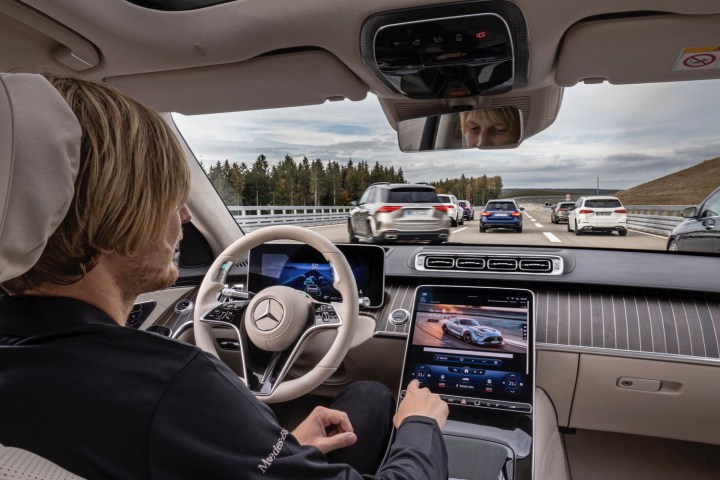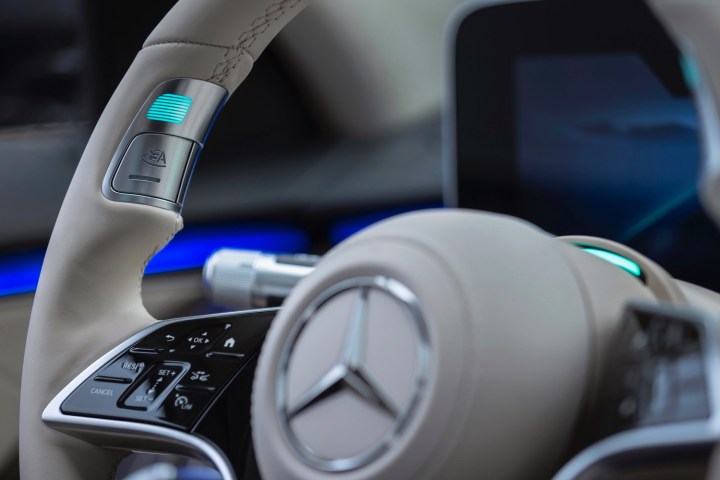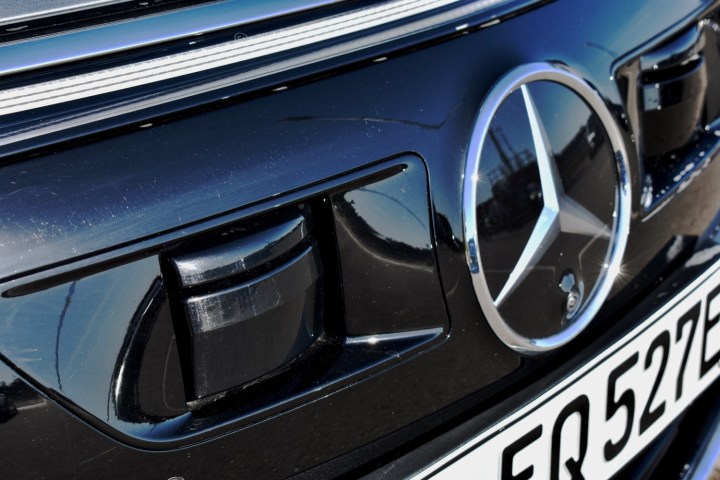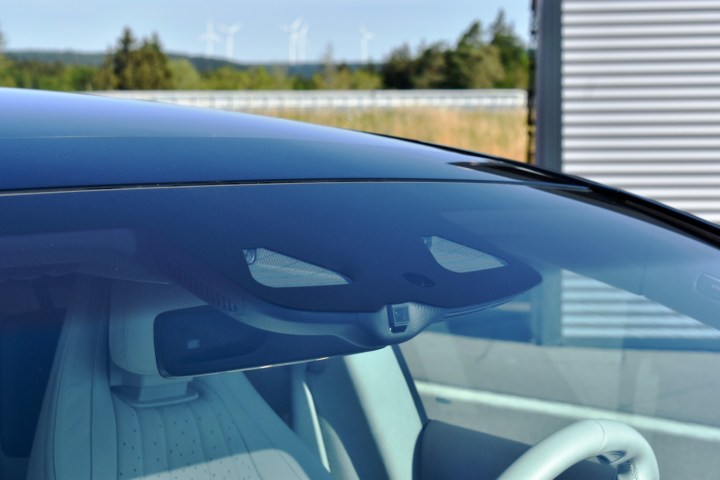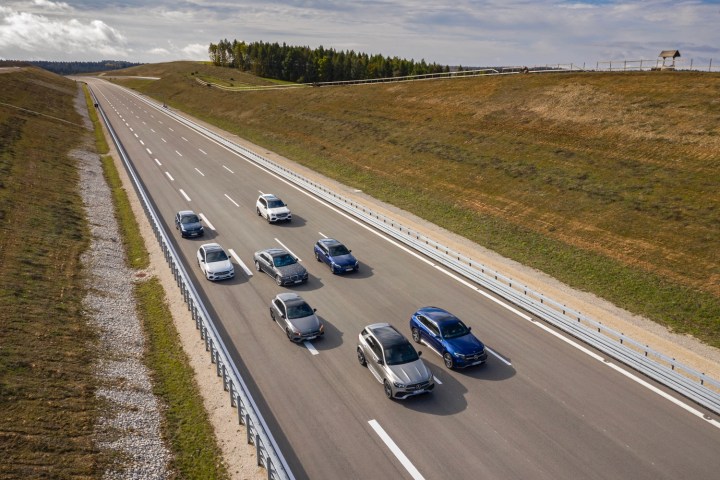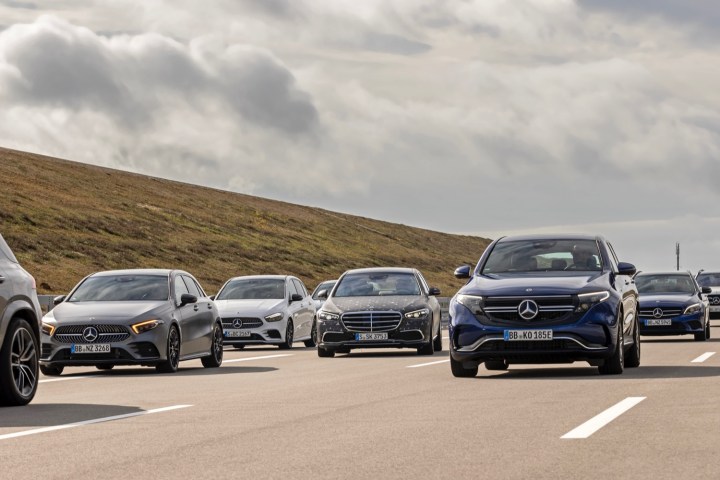You can’t buy a fully self-driving car today — and may never be able to — but automakers are looking at ways to shift more of the workload from human drivers to machinery. Mercedes-Benz may have taken the biggest step in that direction yet.
Mercedes claims its Drive Pilot system, which was recently launched in Germany, is the first production system to achieve Level 3 on the Society of Automotive Engineers (SAE) autonomy scale, meaning the car can fully drive itself with the system active, but a human driver may still need to take over from time to time. It’s still a long way off from autonomous driving, but the Level 3 designation signifies a greater degree of capability than competitor systems.
While Drive Pilot isn’t on sale in the United States yet, we got a taste of just how capable it is during a test drive in a Mercedes-Benz EQS electric car at the automaker’s proving ground in Immendingen, Germany.
Leveling up
With Drive Pilot, Mercedes has placed itself in an unusual position. The SAE autonomy scale goes from Level 0, signifying complete manual operation, to Level 5, signifying cars that can drive themselves in all conditions. Level 3 is the halfway point between those two extremes but, crucially, it’s also the only level that blends human and machine control.
According to the SAE, when a Level 3 system is operating, the car is driving. However, it can still ask the driver to take over control. That stipulation is unique to Level 3. At Levels 4 and 5, the car shouldn’t require human intervention, per the SAE standards, while at Levels 0-2 the driver is considered to be in charge at all times. That includes systems like General Motors’ Super Cruise and Ford’s BlueCruise, where drivers may be merely supervising without touching the steering wheel or pedals.
With Drive Pilot, Mercedes has placed itself in an unusual position.
This ambiguity has led many automakers to avoid Level 3 and aim for the higher levels of automation. While Tesla markets its most advanced driver-assist system as “Full Self-Driving,” Mercedes is the first automaker to get an outside certification for operation above Level 2 with a production-ready system. The German Federal Motor Transport Authority (KBA) approved the use of Drive Pilot in both the EQS and the Mercedes-Benz S-Class in late 2021, allowing Mercedes to offer the system to customers in its home market.
Even with that approval, Drive Pilot is limited to just 37 mph, so you won’t see German businesspeople blasting down the left lane of an autobahn with their hands off the wheel. It also works only on specific stretches of divided highway, and only in daytime with clear weather. The system will also ask the driver to take over if it spots an emergency vehicle, as it has no way of knowing if said vehicle is an ambulance trying to get past or a police car trying to pull you over.
Mercedes is my copilot
Mercedes kept the interface fairly simple. A pair of buttons at the 10 o’clock and 2 o’clock positions on the steering wheel activate Drive Pilot, and an instrument cluster icon confirms the system is active.
Once everything is go, you can take your hands off the wheel and your feet off the pedals, but can’t completely check out. A camera monitors for distraction, and the system will sound a warning if you look away from the road for too long. If the driver doesn’t respond or becomes incapacitated, the car will automatically decelerate and pull over to the side of the road.
The system will sound a warning if you look away from the road for too long.
As with hands-off systems from GM and Ford, we appreciated the use of driver monitoring. It not only prevents drivers from taking a nap behind the wheel, but also makes it less likely that drivers will inadvertently deactivate Drive Pilot. Some driver-assist systems rely on a driver gripping the steering wheel to check that they are still paying attention, but tugging too hard can be misinterpreted as an attempt to retake manual control.
Nonetheless, Mercedes said some infotainment features not normally available while driving are active with Drive Pilot. In practice, we found that the system would allow us to briefly look down at the EQS’ massive 56-inch Hyperscreen display, or glance over at the Mercedes engineer who was narrating our drive from the passenger’s seat, before sounding the alarm.
Always be scanning
While everything feels fairly normal on the inside, Drive Pilot-equipped cars bristle with extra sensors to maintain a constant state of awareness that (in theory) exceeds distraction-prone human drivers.
On top of the radar units and cameras already used for more basic features like adaptive cruise control, Drive Pilot adds lidar and stereo cameras at the front, and a rear-facing camera and microphones in the back window. The latter are primarily for detecting the lights and sirens of emergency vehicles. Moisture sensors in the wheel wells check if it’s too wet for Drive Pilot to safely operate.
Cars bristle with extra sensors to maintain a constant state of awareness.
In addition to the sensors, Drive Pilot includes redundant steering and braking hardware so the driver can still take control even if the system is having issues. Drive Pilot also relies on an upgraded GPS antenna and detailed HD maps. Sensor data is constantly compared against GPS data and the maps for accuracy. The maps, which are much more detailed than those used for conventional navigation systems, are also continuously updated to account for changes in road conditions and events like crashes.
All of this means, should Mercedes launch Drive Pilot in the U.S., it won’t be able to push the system to existing owners via software update like Ford did with its BlueCruise system. That may disappoint some customers, but the added hardware helps ensure reliable operation.
Drive Pilot passes its driver’s test
Our test drive took place on a closed course simulating a stretch of highway, with multiple cars and trucks around us. The choreographed traffic replicated a number of common scenarios, from slow-moving vehicles to aggressive drivers cutting across lanes. Drive Pilot was unphased by everything.
With the system activated, we were truly passengers as our Mercedes EV followed the ebb and flow of traffic. It slowed down to match the speed of a dump truck, unflinchingly held station when a car cut in front, and steered around a stopped car. All of this was done with a smoothness human drivers should aspire to. It’s this behavior that really sets Drive Pilot apart. We’ve seen things like automated lane keeping and lane changes before, but Drive Pilot had a level of finesse that justified using the system rather than doing everything ourselves.
Rather than just manipulating controls, Drive Pilot can also respond like a human driver — in certain situations, at least. In Germany, it’s programmed to pull the car all the way over to the right side of its lane when an emergency vehicle approaches, following local rules that require drivers to create a space for those vehicles (as mentioned above, it then hands control back to the driver). That ability to adapt to local regulations could ease the adoption of Drive Pilot in different markets.
Depending on your standards of road etiquette, Drive Pilot might be too much like a human driver. When a vehicle stopped abruptly in front of us, the system brought our car to a quick stop and then honked the horn. It seems Mercedes has the habits of New York drivers in mind.
To Level 3… and beyond?
Drive Pilot is indeed a step above other driver-assist systems. It performs better, with smooth control inputs and responses that are quick but not jarring. Mercedes has also thoroughly developed the whole package, from the sensor suite to governing software that give the system more awareness of the environment a car is traveling through.
But where does this technology go from here? Mercedes is looking to offer Drive Pilot in the U.S., but the regulatory situation could prevent that. With no federal rules governing this tech, individual states have developed differing regulations of their own. Mercedes likely won’t sell a feature that’s legal in one state but not in another.
Drive Pilot is also available only in the most expensive Mercedes luxury sedans — the electric EQS and gasoline S-Class. Mercedes does have a history of debuting technology on its flagship models — such as anti-lock brakes and stability control — that proliferated to the point of being mandated on all new cars in the U.S. But it might be a while before you can get a Drive Pilot equivalent in a Toyota Corolla.
Another luxury?
The many sensors that enable Drive Pilot also add cost. Lidar in particular has a high per-unit cost, and the positioning of lidar sensors in the grille of Drive Pilot-equipped cars means they’re likely to get damaged in a collision. Drive Pilot also requires a data connection and constantly-updated maps, the cost of which may need to be passed on to customers to create a solid business case for this tech.
The need to add more sensors and connectivity also contradicts a popular misconception: that Level 3 tech inevitably leads to fully autonomous driving. Just as new hardware was needed to get from Level 2 to Level 3, even more will likely be needed to reach Levels 4 and 5. That will also require mapping more roads, and taking Drive Pilot beyond divided highways. That adds development costs and pushes the limits of the technology, which may not work as well beyond the relatively controlled environment of highways.
It’s also important to note that, while it may improve safety, Drive Pilot is really about convenience. Being more attentive than the average human will almost certainly prevent some crashes, but most of the time Drive Pilot’s main function will be de-stressing the plutocrats wealthy enough to afford it. This technological marvel will, as the name says, pilot cars through stop-and-go traffic, taking some of the mental load off drivers.
Drive Pilot, then, might be more comparable to the luxury features offered in high-end Mercedes cars — the big touchscreens and massaging seats — than any pioneering safety tech. It’s a nice feature to have, but may not be the future of automotive safety. Because while human drivers leave a lot to be desired, taking people out of the loop doesn’t automatically make a car safer.
Editors' Recommendations
- Mercedes G580 electrifies an off-road icon
- How do you crash-test an EV with an 871-pound battery? Mercedes showed us
- Volkswagen is launching its own self-driving car testing program in the U.S.
- Mercedes is finally bringing an electric van to the U.S.
- 2023 Mercedes-Benz EQE SUV preview: The EV lineup grows again
